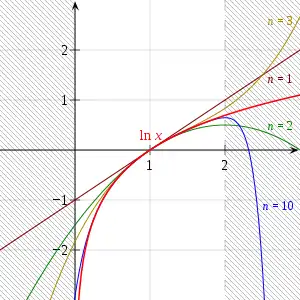
In mathematics, the Mercator series or Newton–Mercator series is the Taylor series for the natural logarithm:
The series converges to the natural logarithm (shifted by 1) whenever .
History
The series was discovered independently by Johannes Hudde[1] and Isaac Newton. It was first published by Nicholas Mercator, in his 1668 treatise Logarithmotechnia.
Derivation
The series can be obtained from Taylor's theorem, by inductively computing the nth derivative of at , starting with
Alternatively, one can start with the finite geometric series ()
which gives
It follows that
and by termwise integration,
If , the remainder term tends to 0 as .
This expression may be integrated iteratively k more times to yield
where
and
are polynomials in x.[2]
Special cases
Setting in the Mercator series yields the alternating harmonic series
Complex series
The complex power series
is the Taylor series for , where log denotes the principal branch of the complex logarithm. This series converges precisely for all complex number . In fact, as seen by the ratio test, it has radius of convergence equal to 1, therefore converges absolutely on every disk B(0, r) with radius r < 1. Moreover, it converges uniformly on every nibbled disk , with δ > 0. This follows at once from the algebraic identity:
observing that the right-hand side is uniformly convergent on the whole closed unit disk.
See also
References
- ↑ Vermij, Rienk (3 February 2012). "Bijdrage tot de bio-bibliografie van Johannes Hudde". GEWINA / TGGNWT (in Dutch). 18 (1): 25–35. ISSN 0928-303X.
- ↑ Medina, Luis A.; Moll, Victor H.; Rowland, Eric S. (2011). "Iterated primitives of logarithmic powers". International Journal of Number Theory. 7 (3): 623–634. arXiv:0911.1325. doi:10.1142/S179304211100423X. S2CID 115164019.
- Weisstein, Eric W. "Mercator Series". MathWorld.
- Anton von Braunmühl (1903) Vorlesungen über Geschichte der Trigonometrie, Seite 134, via Internet Archive
- Eriksson, Larsson & Wahde. Matematisk analys med tillämpningar, part 3. Gothenburg 2002. p. 10.
- Some Contemporaries of Descartes, Fermat, Pascal and Huygens from A Short Account of the History of Mathematics (4th edition, 1908) by W. W. Rouse Ball